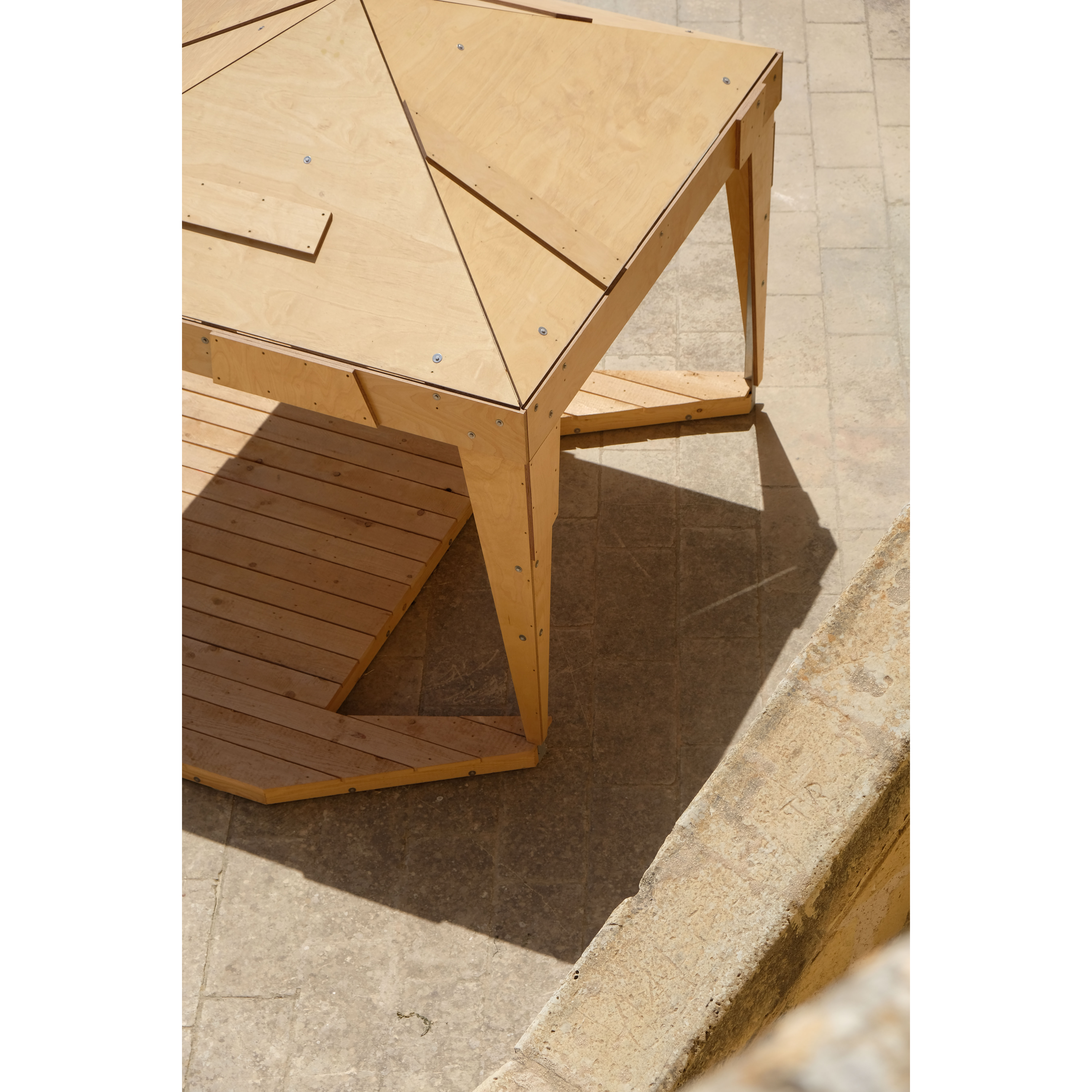Malta Biennale





Installed on Cittadella Bastions in Gozo, this temporary structure crafted from timber, serves as both a tiny public shelter and a starting point for reflecting on the presence of objects in everyday life. The work can be seen as the artist's personal interpretation of the contemporary polyester pop-up gazebo that seems to appear everywhere - taking over beach spots, occupying public squares for entertainment, and privatising streets for film productions.
With their unmistakable shape, they have become a marker of our time and reflect how we claim shared spaces for private use. In a place as busy as this island, with limited physical space available, finding a balance between the ease of taking over public spaces and the need for shared spaces raises questions. What defines 'publicness,' and where do we draw boundaries?
There's no denying the utility of these lightweight structures — they provide much-needed shade and shelter, especially in times of changing climate patterns. However, they also represent an unsustainable industry of mass-produced goods that colonise our public spaces, gradually becoming part of our contemporary vernacular. How do we reconcile these contradictions?
Van Malderen makes a statement by replacing the gazebo's flexible polyester cover with a patchwork of timber, reminiscent of an older vernacular. He transposes the informal panelling of a timber shack onto our 'contemporary shack,' prompting consideration about the materials we surround ourselves with. By changing the gazebo's typically flexible and easily movable nature into a fixed and stable structure, he invites us to reflect on the passage of time and the speed of consumption.
Reproducing the gazebo one-third smaller adds a humorous touch, reducing its practicality and limiting its use to children and young adolescents. The addition of a thin plinth, shaped like the shadow of the gazebo, serves as a reminder that objects often occupy more space than the objects themselves, and more than we acknowledge most of the time.
Van Malderen uses this reproduction of a well-known object as a catalyst for contemplating form, material, meaning, culture, and politics. The act of remaking becomes a tool for transformation and questioning the original logic of the gazebo. It encourages us to ponder the use of space and materials as they shape our memory, identity, and perspectives.
With their unmistakable shape, they have become a marker of our time and reflect how we claim shared spaces for private use. In a place as busy as this island, with limited physical space available, finding a balance between the ease of taking over public spaces and the need for shared spaces raises questions. What defines 'publicness,' and where do we draw boundaries?
There's no denying the utility of these lightweight structures — they provide much-needed shade and shelter, especially in times of changing climate patterns. However, they also represent an unsustainable industry of mass-produced goods that colonise our public spaces, gradually becoming part of our contemporary vernacular. How do we reconcile these contradictions?
Van Malderen makes a statement by replacing the gazebo's flexible polyester cover with a patchwork of timber, reminiscent of an older vernacular. He transposes the informal panelling of a timber shack onto our 'contemporary shack,' prompting consideration about the materials we surround ourselves with. By changing the gazebo's typically flexible and easily movable nature into a fixed and stable structure, he invites us to reflect on the passage of time and the speed of consumption.
Reproducing the gazebo one-third smaller adds a humorous touch, reducing its practicality and limiting its use to children and young adolescents. The addition of a thin plinth, shaped like the shadow of the gazebo, serves as a reminder that objects often occupy more space than the objects themselves, and more than we acknowledge most of the time.
Van Malderen uses this reproduction of a well-known object as a catalyst for contemplating form, material, meaning, culture, and politics. The act of remaking becomes a tool for transformation and questioning the original logic of the gazebo. It encourages us to ponder the use of space and materials as they shape our memory, identity, and perspectives.















